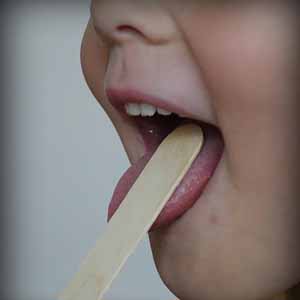Propofol versus lidocaine on prevention of laryngospasm in tonsillectomy: A randomized clinical trial

Accepted: 15 May 2022
HTML: 16
All claims expressed in this article are solely those of the authors and do not necessarily represent those of their affiliated organizations, or those of the publisher, the editors and the reviewers. Any product that may be evaluated in this article or claim that may be made by its manufacturer is not guaranteed or endorsed by the publisher.
Laryngospasm is an important complication of tonsillectomies. This study aimed to compare the effects of propofol versus lidocaine on prevention of laryngospasm in tonsillectomy. This randomized clinical trial included 102 patients who met the inclusion criteria. Patients were randomly divided into two groups treated with 0.5 mg/kg propofol (group P) or 1 mg/kg lidocaine 2% (group L). The frequencies of laryngospasm (within 10 min after extubation), agitation, nausea, vomiting, mean heart rate and mean arterial pressure (MAP) were assessed in both groups. Data were analyzed using SPSS software version 16 at a 95% confidence level. There were no significant differences between the two groups in terms of sex, age or weight. In the P group, the frequency of laryngospasm was significantly lower than L within10 minutes after extubation (4.1% versus 16.3%). Furthermore, the frequencies of agitation (p = 0.003), nausea and vomiting (p = 0.002) and mean heart rate (p = 0.026) were significantly higher in the L group than the P group. However, there were no differences between the two groups in terms of mean systolic and diastolic blood pressure, MAP, SPO2, awakening time, length of stay in recovery and frequency of shivering. Propofol can reduce the incidence of laryngospasm, agitation, nausea and vomiting but it has no effect on the patient's awakening time and length of stay in recovery.
Stalfors J, Ericsson E, Hemlin C, Hultcrantz E, Månsson I, Roos K, et al. Tonsil surgery efficiently relieves symptoms: analysis of 54 696 patients in the National Tonsil Surgery Register in Sweden. Actaoto-laryngologica 2012; 132(5):533-9. DOI: https://doi.org/10.3109/00016489.2011.644252
Al-Metwalli RR, Mowafi HA, Ismail SA. Gentle chest compression relieves extubation laryngospasm in children. Journal of anesthesia 2010;24(6):854-7. DOI: https://doi.org/10.1007/s00540-010-1036-9
De Souza Hobaika AB, Lorentz MN. Laryngospasm. Brazilian Journal of Anesthesiology 2009;59(4):487-95. DOI: https://doi.org/10.1590/S0034-70942009000400012
Hampson‐Evans D, Morgan P, Farrar M. Pediatric laryngospasm. Pediatric Anesthesia 2008;18(4):303-7. DOI: https://doi.org/10.1111/j.1460-9592.2008.02446.x
Mamie C, Habre W, Delhumeau C, BarazzoneArgiroffo C, Morabia A. Incidence and risk factors of perioperative respiratory adverse events in children undergoing elective surgery. Pediatric Anesthesia 2004;14(3):218-24. DOI: https://doi.org/10.1111/j.1460-9592.2004.01169.x
Bolaji B, Oyedepo O, Dunmade A, Afolabi O. Negative Pressure Pulmonary Oedema Following Adenoidectomy Under General Anaesthesia: A Case Series. West African journal of medicine. 2011;30(2):121-4.
Waheed Z, Khan J. Negative pressure pulmonary oedema: a rare complication following general anaesthesia. Journal of the Pakistan Medical Association. 2011;61(3):290.
Koga K, Sata T. Laryngospasm associated with anesthesia: diagnosis and management. Journal of UOEH. 2004;26(1):75-83. DOI: https://doi.org/10.7888/juoeh.26.75
Hernández-Cortez E. Update on the management of laryngospasm. Journal of Anesthesia and Critical Care Open Access 2018;8(2):1-6. DOI: https://doi.org/10.15406/jaccoa.2017.08.00327
Tait AR, Malviya S, Voepel-Lewis T, Munro HM, Siewert M, Pandit UA. Risk factors for perioperative adverse respiratory events in children with upper respiratory tract infections. Anesthesiology: The Journal of the American Society of Anesthesiologists 2001;95(2):299-306. DOI: https://doi.org/10.1097/00000542-200108000-00008
Von Ungern-Sternberg BS, Boda K, Chambers NA, Rebmann C, Johnson C, Sly PD, et al. Risk assessment for respiratory complications in paediatricanaesthesia: a prospective cohort study. The Lancet 2010;376(9743):773-83. DOI: https://doi.org/10.1016/S0140-6736(10)61193-2
Staffel JG, Weissler MC, Tyler EP, Drake AF. The prevention of postoperative stridor and laryngospasm with topical lidocaine. Archives of Otolaryngology–Head & Neck Surgery 1991;117(10):1123-8. DOI: https://doi.org/10.1001/archotol.1991.01870220071012
Sanikop C, Bhat S. Efficacy of intravenous lidocaine in prevention of post extubation laryngospasm in children undergoing cleft palate surgeries. Indian journal of anaesthesia 2010;54(2):132. DOI: https://doi.org/10.4103/0019-5049.63654
Mihara T, Uchimoto K, Morita S, Goto T. The efficacy of lidocaine to prevent laryngospasm in children: a systematic review and meta‐analysis. Anaesthesia. 2014;69(12):1388-96. DOI: https://doi.org/10.1111/anae.12788
Clivio S, Putzu A, Tramèr MR. Intravenous Lidocaine for the Prevention of Cough: Systematic Review and Meta-analysis of Randomized Controlled Trials. Anesthesia and Analgesia. 2019;129(5):1249-1255. DOI: https://doi.org/10.1213/ANE.0000000000003699
Kaur S, Gupta A, Sharma A, Singh M. Role of propofol in prevention of extubation related complications in oral surgery. Journal of Anaesthesiology Clinical Pharmacology. 2006;22(2):155.
Nawfal M, Baraka A. Propofol for relief of extubation laryngospasm. Anaesthesia. 2002;57(10):1036. DOI: https://doi.org/10.1046/j.1365-2044.2002.283810.x
Iqbal M, Qayyum M, Rashid M. Frequency of Laryngospasm following Extubation with and without Propofol at Extubation in Paediatric Patients Undergoing Tonsillectomy. Pakistan Journal Of Medical & Health Sciences 2017;11(1):3-6.
Mokhtar AM, Badawy AA. Low dose propofol vs. lidocaine for relief of resistant post-extubation laryngospasm in the obstetric patient. Brazilian Journal of Anesthesiology. (English Edition) 2018;68(1):57-61. DOI: https://doi.org/10.1016/j.bjane.2017.03.003
Malik A, Butt TA, Akhtar N, Ashraf Z. Efficacy of Intravenous Lidocaine in Preventing Laryngospasm in Children Undergoing Tonsillectomy. Pakistan Journal Of Medical & Health Sciences. 2016;10(4):1182-6.
Batra YK, Ivanova M, Ali SS, Shamsah M, Qattan ARA, Belani KG. The efficacy of a subhypnotic dose of propofol in preventing laryngospasm following tonsillectomy and adenoidectomy in children. Pediatric Anesthesia. 2005;15(12):1094-7. DOI: https://doi.org/10.1111/j.1460-9592.2005.01633.x
PAGEPress has chosen to apply the Creative Commons Attribution NonCommercial 4.0 International License (CC BY-NC 4.0) to all manuscripts to be published.


 https://doi.org/10.4081/ejtm.2022.10581
https://doi.org/10.4081/ejtm.2022.10581



